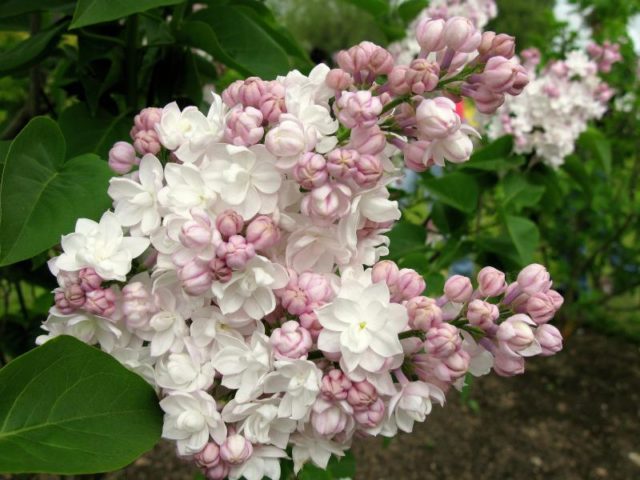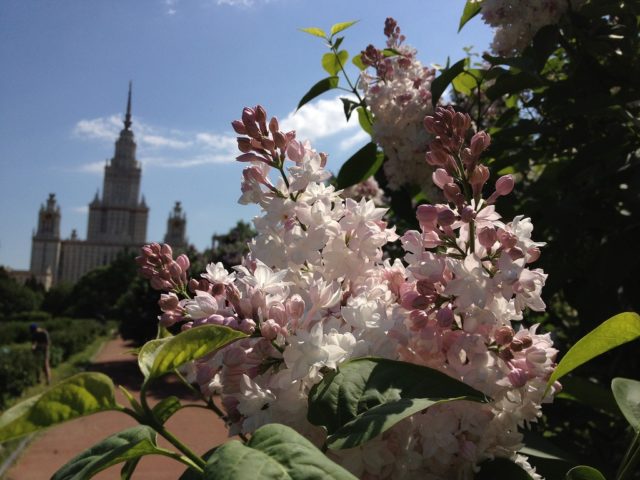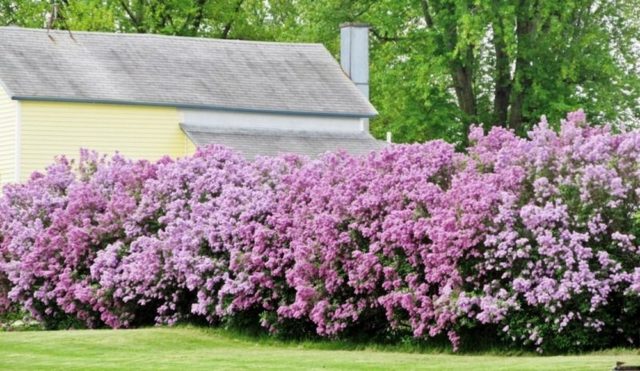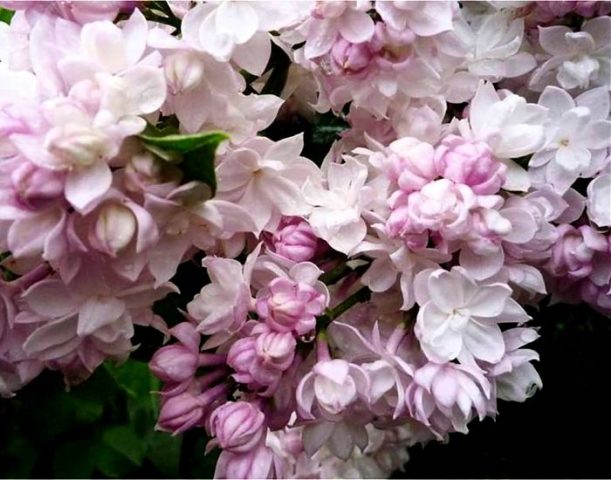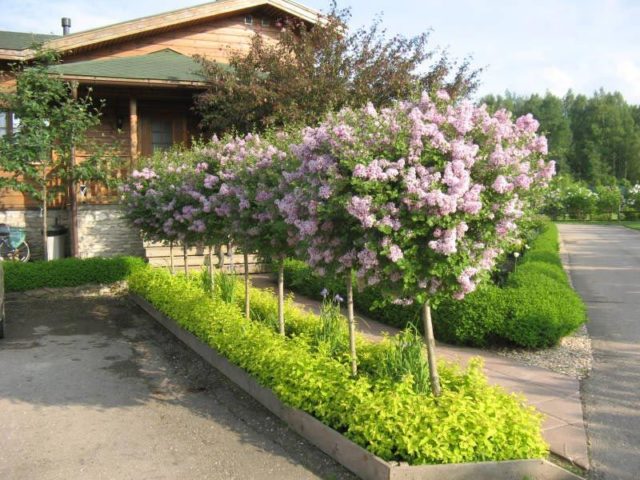Content
Description, photos and reviews of the lilac Beauty of Moscow speak of the variety as one of the most beautiful not only in Russia, but also in the world. Breeder L.A. Kolesnikov created the lilac Beauty of Moscow in 1947 on the basis of the own cultivar “I.V. Michurin "and the French" Belle de Nancy ". Picturesque shrubs are used for landscaping the site and cutting into bouquets.
Description of lilac Beauty of Moscow
Lilac Beauty of Moscow is a multi-stemmed deciduous shrub. Refers to the species common lilac. The height of the lilac bush Beauty of Moscow in adulthood reaches 3-4 m.
The bush grows sprawling with strong branches. The leaves are opposite, large, simple, ovate-elongated. Top - smooth, bright green, bottom - with a slight dullness. The leaves fall green. In the photo of the ordinary lilac Beauty of Moscow, large buds of pink-purple color are visible. Frost resistance and drought resistance of the variety is good.
How the lilac blooms Moscow beauty
Common lilac The beauty of Moscow belongs to the I group of white lilacs. The flowers are white with a light, visible lilac bloom in the middle, symmetrical, double-shaped. The size of the flower is 2-2.5 cm. The petals are raised, bent inward.
Blooms profusely. The inflorescences are arranged vertically, consist of 1-2 strong panicles, 25 by 12 cm in size. The flowers have a rich aroma. Flowering lasts 3 weeks, from May to June.
Breeding features
A feature of the cultural variety of lilacs Beauty of Moscow is that reproduction is possible only in a vegetative way. With the seed method, parental characteristics are not transferred.
One of the simplest ways of vegetative propagation is by layering. The lateral shoot is pressed into a groove in the soil and independent shoots with roots are formed on it, which are then separated from the parent shoot. Cutting lilacs The beauty of Moscow is only green shoots. Semi-lignified and lignified cuttings root poorly.
One of the most difficult ways to propagate a shrub is by grafting. This method is used in nurseries because it requires certain knowledge and skills.
Planting and caring for lilacs Beauty of Moscow
In the photo of the lilac Beauty of Moscow in landscape design, it can be seen that the shrub is planted, both in a single planting and in a group.
In groups between individual plants, a distance of 1 m is observed, taking into account the growth of crops. The photo shows that the Moscow beauty lilac is used to form hedges, break down alleys.
Recommended timing
In the middle lilac variety, the Beauty of Moscow lilac variety is planted from mid-summer to early autumn. Seedlings with open roots are planted as soon as possible after digging. With a closed root system - during the growing season. Young plants take root better than adult bushes.
Site selection and soil preparation
Lilac Beauty of Moscow grows well in shade, but not constant. Shows abundant flowering only when growing in illuminated areas.
The description of the lilac variety Krasavitsa Moskvy says that the preferred soils for cultivation are fertile, well-drained loams.
How to plant correctly
For planting, choose a cloudy day or evening. The size of the planting pit depends on the original quality of the soil and is usually twice the size of the earthen ball. The depth of the planting pit is made according to the height of the seedling. In an unsuitable area, a larger hole is dug in order to replace the soil with light and fertile. Clay or heavy soils are loosened with a mixture of fertile soil and sand. Soil with an acidic reaction is preliminarily deoxidized with lime or dolomite flour. A drainage layer is laid out at the bottom of the planting pit.
Part of the fertile layer is poured onto the drainage. The seedling is released vertically into the pit, the root collar is not buried. The roots are evenly distributed.
When covered with soil, voids should not form so that the roots do not dry out. Therefore, the soil is well compacted after planting. After planting, an earthen roller is constructed along the diameter of the trunk so that the water does not spread during irrigation. Then the plant is watered abundantly. Mulch is applied to the soil surface.
Growing lilacs Moscow beauty
Reviews of the lilac Beauty of Moscow describe the shrub as unpretentious. Growing and caring for lilacs The beauty of Moscow is weeding, mulching, feeding and watering.
Watering
The Krasavitsa Moscow variety is drought-resistant. But for abundant flowering with a lack of moisture from atmospheric precipitation, the bushes are watered additionally. In hot weather, the amount of watering is increased. Young plants are watered more often than adults. In September, it is intensively watered underground to form new roots.
Top dressing
Top dressing of lilacs Beauty of Moscow begins from the second year of cultivation. Mineral and organic fertilizers are used. Top dressing is carried out three times per season. The first time in the spring, after thawing the soil - with nitrogen-containing fertilizers, the next - with an interval of 20-25 days - using infusions of mullein, slurry or ash.
Mulching
The soil under the bush is mulched with peat, humus or tree bark. A protective layer is poured 5-7 cm high, 5 cm away from the center of tillering. Mulching helps the soil not to overheat, inhibits the growth of weeds.
A favorable microenvironment is created under the mulch, in which the shrub grows strong and healthy, and is less affected by diseases.
Pruning
The shrub tolerates pruning well. The degree of pruning depends on the size of the shoots and the desired shape of the shrub. In adult bushes, stems with weak growth are cut at soil level.
To make the Beauty of Moscow lilac bloom profusely every year, the dried inflorescences of the current year, along with part of the branch, are cut off in time.
You can form a standard plant yourself. This will take about 5 years. The strongest shoot is chosen, which becomes the future stem, and side shoots are regularly removed from it.
A sharp, clean garden tool is used for trimming the shrub. To avoid damage to the shrub, branches are not recommended to break out.
Preparing for winter
In the fall, after the foliage has fallen off, the branches are cleared of lichens, the remnants of the leaves are removed. The bush is sprayed with copper-containing preparations. Mature shrubs do not need shelter. The soil around the young seedlings is covered with peat or humus, with a layer of 10-15 cm. In winter, the bush is covered with snow. Lilac The beauty of Moscow on a trunk is less resistant to cold weather. Boards for the winter are covered with burlap or light non-woven materials.
Diseases and pests
The plant has a high resistance to various pathogenic organisms. The shrub can be damaged by lilac moths and lilac hawk moths.Caterpillars parasitize on the leaves of the plant, hibernate in the soil. The affected specimen loses its decorative effect, slows down growth and blooms little. If pests are found, the bush is sprayed before and after flowering with insecticides, for example, Iskra or Inta-Vir.
Lilacs are least of all ornamental shrubs affected by diseases. But a weakened plant is susceptible to viral, mycoplasma, fungal and bacterial infections. Only fungal lesions can be treated. To prevent the occurrence, ornamental shrubs, like the rest of the garden, are sprayed with broad-spectrum fungicides in the spring. They create a healthy environment, clean the growing area from weeds, and feed them on time.
Conclusion
Description, photos and reviews of the lilac Beauty of Moscow show one of the most beautiful varieties of flowering shrubs. Lilac is distinguished not only by its decorative effect, but also by its ability to purify the air. Lilac variety Beauty of Moscow is not difficult to care for and grow, pleases gardeners with fragrant May bloom.
